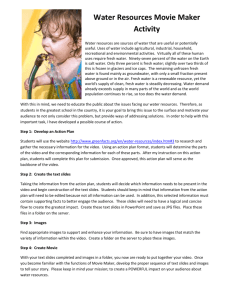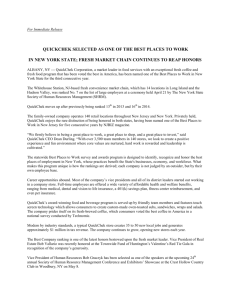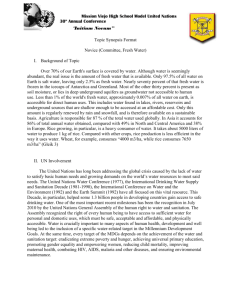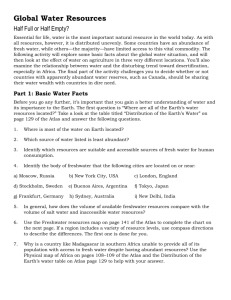Water resources
advertisement
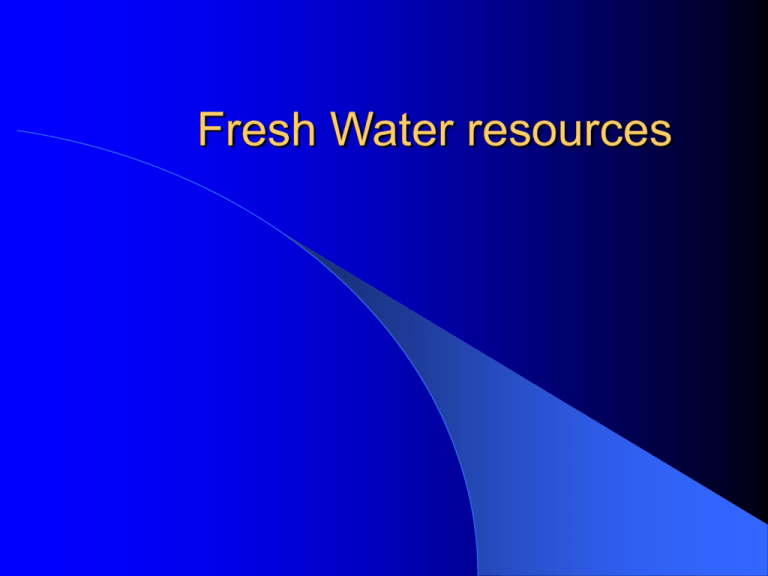
Fresh Water resources Global Overview While 67% of Earth’s surface is covered by water, only less than 2.7% of global water is freshwater. Most of the freshwater (2.05%) are locked in ice caps and glaciers. Only less than 0.7% is available for human use. Over two thirds of the earth's surface is covered with water, 97.2% of which is contained in the five oceans. The Antarctic ice sheet, containing 90% of all fresh water on the planet, is visible at the bottom. Atmospheric water vapour can be seen as clouds, contributing to the earth's albedo. Iceberg and Polar cap store most of the fresh water on Earth Volume of water stored in the water cycle's reservoirs Reservoir Ocean Ice caps & glaciers Groundwater Lakes Soil Moisture Atmosphere Streams & rivers Biosphere Volume of water (106 km³) 1370 29 9.5 0.125 0.065 0.013 0.0017 0.0006 Percent of total 97.25 2.05 0.68 0.01 0.005 0.001 0.0001 0.00004 Scarcity of fresh water On a global basis, fresh water is a increasingly scarce resource. It is partially caused by increasing population coupled by change of consumption pattern and climate changes. Water consumption for food production (I) Meat production use a lot of water when compared to growing food crops. A shift in food consumption pattern toward more meat consumption will cause a substantial increase in water consumption. Water consumption for food production (II) Competing water uses (I) Competing water uses (II) Industrialized / developed countries tend to use more water in their industrial production. Other countries tend to use more water for agricultural uses. Fresh Water supply Problems related to Water crisis Inadequate access to safe drinking water by over 1.1 billion people Groundwater overdrafting leading to diminished agricultural yields Overuse and pollution of water resources harming biodiversity Regional conflicts over scarce water resources sometimes resulting in warfare. Threats to fresh water resources Climate change causes change in frequencies of droughts and floods. Depletion of aquifers caused by overconsumption as a result of population growth. Pollution and contamination by sewage, agricultural and industrial runoff. Distribution of population and water resources Pressure of freshwater ecosystem Fresh Water Outlook Estimated from existing data, some countries are going to experience serious shortage of fresh water supply in the coming 20 years time. China, India and South Africa and Middle East countries may among the most adversely affected countries. Water in China According to the World Bank forecast, Mainland China has only a per-capita share of 2700 cubic meters per annum, one fourth of the world's average at present. Half of China's 617 largest cities face water deficits. Beijing is among the most water-short. The areas south of the Yangtze River, China's longest, which account for only 36.5 per cent of the country's total territory, have 80.9 per cent of its total water resources. However the areas north of the Yangtze, which make up 63.5 per cent of China, possess only 19.1 per cent of total water resources. Desalination of sea water as fresh water supply Desalination of sea water can be done either via distillation or membrane process. Both process requires large amount of energy and thus costly, which means desalination remains an expensive option for providing reliable fresh water supply, restricted to only economically well-off countries.

